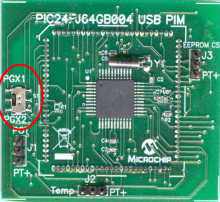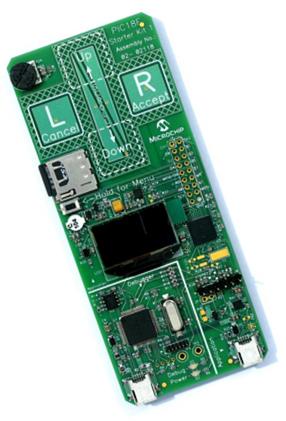Getting Started: Running the “Device
– Composite – WinUSB + MSD” demo
Configuration
1: PIC18F87J50 PIM
Configuration
3: PIC18F46J50 Full Speed USB Demo Board
Configuration
4: PIC32 USB Starter Board
Configuration
5: PICDEM FS USB
Configuration
6: PIC24F Starter Kit 1
Configuration
7: PIC18F Starter Kit
Configuration
1: PIC18F87J50 PIM
Configuration
3: PIC18F46J50 Full Speed USB Demo Board
Configuration
4: PIC32 USB Starter Board
Configuration
5: PICDEM FS USB
Configuration
6: PIC24F Starter Kit 1
Configuration
7: PIC18F Starter Kit
Required Hardware:
To run this project, you will need one of the
following sets of hardware:
Configuration 1: PIC18F87J50 PIM
PIC18F87J50
Plug-In-Module (PIM) (MA180021)
Configuration 2: Explorer 16
Explorer
16 (DM240001)
USB
PICtail™ Plus Daughter Card (AC164131)
And one of the following PIMs
PIC24FJ64GB004
Plug-In-Module (PIM) (MA240019)
PIC24FJ256GB110 Plug-In-Module (PIM) (MA240014)
PIC32MX460F512L Plug-In-Module (PIM) (MA320002)
PIC32MX795F512L Plug-In-Module (PIM) (MA320003)
dsPIC33EP512MU810 Plug-In-Module
(PIM)
PIC24EP512GU810 Plug-In-Module
(PIM)
Configuration 3: PIC18F46J50 Full Speed USB Demo Board
PIC18F46J50
Full Speed USB Demo Board (MA180024)
Configuration 4: PIC32 USB Starter Board
PIC32 USB Starter Board (DM320003)
Configuration 5: PICDEM FS USB
PICDEM
FS USB (DM163025)
Configuration 6: PIC24F Starter Kit 1
PIC24F
Starter Kit 1 (DM240011)
Configuration 7: PIC18F Starter Kit
PIC18F Starter Kit (DM180021)
Configuring the Hardware:
This
section describes how to set up the various configurations of hardware to run
this demo.
Configuration 1: PIC18F87J50 PIM
Configuration 3: PIC18F46J50 Full Speed USB Demo Board
Configuration 4: PIC32 USB Starter Board
Configuration 5: PICDEM FS USB Board
Configuration 6: PIC24F Starter Kit 1
Configuration 7: PIC18F Starter Kit
Configuration 1: PIC18F87J50 PIM
1)
Short JP4 on the PIC18F87J50 PIM. This
allows the demo board to be powered through bus power.
2)
Short JP1 such that the “R” and “U” options are shorted.
Configuration 2: Explorer 16
1)
Before attaching the PIM to the Explorer 16 board, insure that the processor
selector switch (S2) is in the “PIM” position as seen in the image below.
2)
Short the J7 jumper to the “PIC24” setting
3)
Before connecting PIM to the Explorer 16 board, remove all attached cables from
both boards. Connect the PIM to the
Explorer 16 board. Be careful when
connecting the boards to insure that no pins are bent or damaged during the
process. Also insure that the PIM is not
shifted in any direction and that all of the headers are properly aligned.
3a)
If using the PIC24FJ64GB004 PIM, please insure that the programming port
switch is switched in the PGX1 direction.

4) On the USB PICTail Plus board, short jumper
JP1. Remove all other shorts on the
board.
5) Connect the USB PICTail Plus board to either
of the female PICTail Plus connectors or on the card edge connector (J9) at the
edge of the Explorer 16 board.
Note: When using the HID bootloader for PIC32, it is
important to modify the procdefs.ld file to relocate the sections of code that
will hold the bootloader and those sections that will hold the user
application. Example modified
procdefs.ld files have been provided with each project. This file is currently named
“Procdefs.ld.boot”. When using the
example project with the bootloader it is required to remove the “.boot”
section of the file. This will allow
MPLAB to use this file instead of the default linker file. Once the linker file is renamed, however, the
project will no longer work without the bootloader. Please rename the file in order to get the
project working again with PIC32.
Configuration 3: PIC18F46J50 Full Speed USB Demo Board
1) Short JP3 to allow the board to
be powered from the USB.
.jpg)
Configuration 4: PIC32 USB Starter Board
No specific hardware configuration is required for this
demo.

Configuration 5: PICDEM FS USB
1)
If using the
PICDEM FS USB Demo Board, no hardware related configuration or jumper setting
changes should be necessary. The demo
board need only be programmed with appropriate firmware.
Configuration 6: PIC24F Starter Kit 1
The PIC24F Starter Kit does not require any hardware setup
to run this demo. This demo does,
however, require the user to change the default selected device in the project before
compiling the demo.
1) Open the associated project file
for C30
2) In MPLAB Select
“Configure->Select Device”
3) In the device list box in the top
left corner of that window, select “PIC24FJ256GB106”
Configuration 7: PIC18F Starter Kit
No specific hardware configuration is required for this
demo.

To
run this project, you will need to load the corresponding firmware into the
devices. There are two methods available
for loading the demos: Precompiled demos and source code projects.
Precompiled
Demos are available in the “<Install Directory>\USB – Precompiled Demos”
folders. Each demo should be prefaced
with the hardware platform it is compiled for.
Select the file that matches the hardware that you have and the demo
that you want to run. For more
information about how to load a precompiled project, please see the “Getting
Started – Loading a precompiled demo” guide.
The
source code for this demo is available in the “<Install Directory\USB Device
– Composite – WinUSB + MSD” directory.
In this directory you will find all of the user level source and header
files as well as project and workspace files for each of the hardware
platforms. Find the project (*.mcp) or
workspace (*.mcw) file that corresponds to the hardware platform you wish to
test. Compile and program the demo code
into the hardware platform. For more
help on how to compile and program projects, please refer to the MPLAB® IDE
help available through the help menu of MPLAB (Help->Topics…->MPLAB IDE).
Please
note that when using either the C30 or C32 demo projects you will be required
to select the correct processor for the demo board.
1) Open the associated project file
2) In MPLAB Select
“Configure->Select Device”
3) In the device list box in the top
left corner of that window, select the desired device.
This demo uses the selected hardware platform as both a flash
drive using the internal flash as storage and WinUSB class USB device. It will appear to the computer as if two USB
devices were attached.
For details how to run the demo for each of the functions please
see the respective getting started documents: “USB
Device – Mass Storage – Internal Flash” and “USB
Device – WinUSB – Generic Driver Demo”.
Demo Notes:-
1)
For
PIC24F Starter Kit 1, “Get pushbutton
State” functionality is not implemented.
2)
For
PIC18F Starter Kit 1, “Toggle LED”
functionality is not implemented.
Trademarks:
The Microchip name and logo, the Microchip logo,
MPLAB, and PIC are registered trademarks of Microchip Technology Incorporated
in the
PICDEM and PICTail are trademarks of Microchip
Technology Incorporated in the
Microsoft, Windows, and Windows Vista are either
registered trademarks or trademarks of Microsoft Corporation in the


.JPG)
.JPG)
.JPG)
